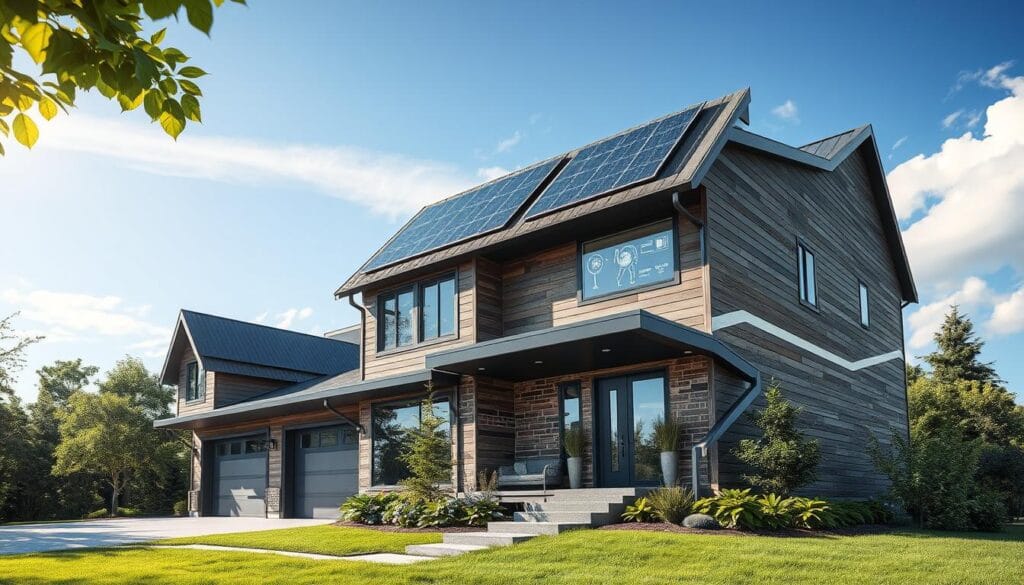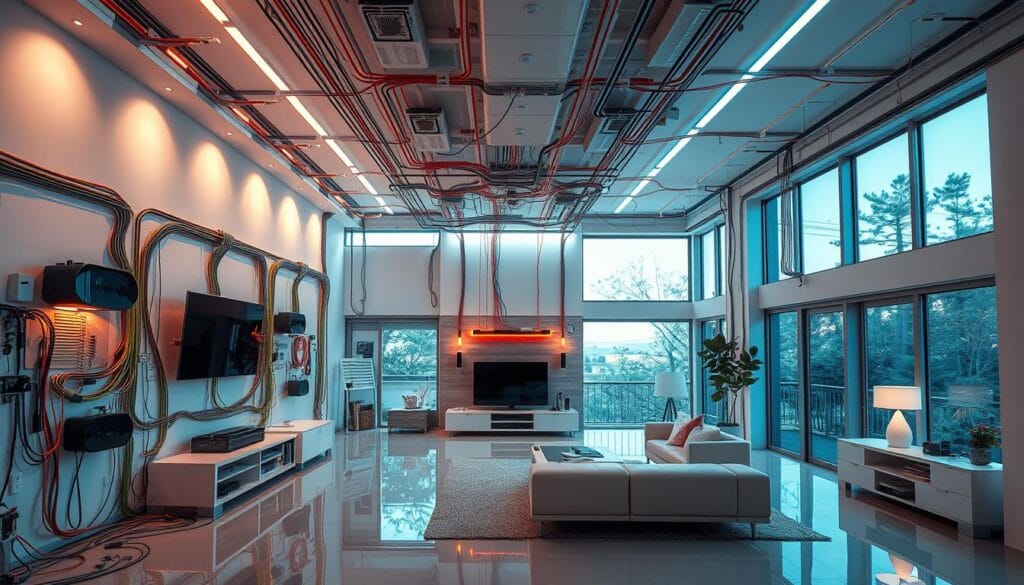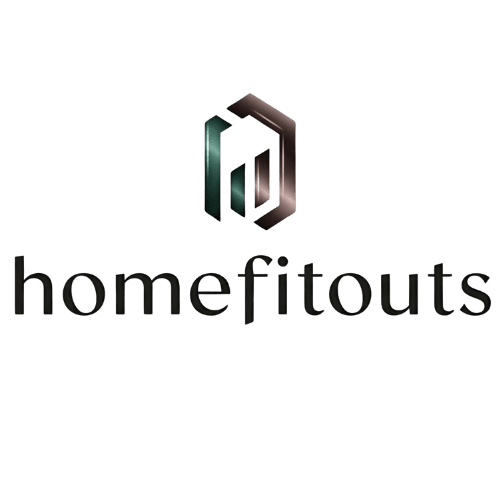We’re entering a new era where homes are getting smarter and more connected. Future-proof smart homes are now a reality. It’s key to keep up with the fast pace of smart home tech.
Home automation systems are changing how we live. They bring us convenience and efficiency. In the U.S., 45% of homes with internet have smart devices, showing a big interest in these techs.
Going smart isn’t just about cool gadgets. It’s about making homes that fit our needs, save energy, and keep us safe. A third of Gen Z and millennials want homes that save energy, showing they care about the planet.
By using smart home tech, we’re not just making our lives better, we are making ourselves future-proof. We’re also making our homes safer for the future. With home accidents going up 25% from 2015-2021, smart systems help prevent these issues and protect our homes.
Key Takeaways
- Smart home adoption is rapidly increasing in the U.S.
- Energy efficiency is a top priority for younger homeowners
- Home automation systems can help prevent accidents and losses
- Scalable smart solutions offer easy upgrades as needs change
- Future-proofing homes involves integrating various intelligent technologies
- Climate-proofing is becoming essential in home design and upgrades
Understanding the Smart Home Revolution
The smart home revolution is changing how we live. It brings us convenience and makes our lives more efficient. We’re seeing more connected home devices that make our homes smarter and more responsive.
What defines a smart home?
A smart home uses internet-connected devices to control our living space. These devices help with security and make our homes energy-efficient. They work together to make our lives easier.
The growth of smart home adoption
More and more people are adopting smart homes. By 2025, the global smart home market will hit $135 billion. This growth is because smart tech is getting cheaper and easier to use.
| Year | Market Value | Cost Decrease |
|---|---|---|
| 2023 | $100 billion | – |
| 2025 | $135 billion | 15% (lighting systems) |
Benefits of smart home technology
Smart homes have many benefits:
- They offer better security with advanced surveillance
- They save energy with smart thermostats and lights
- They make our homes more comfortable with automated climate control
- They let us control devices from anywhere
These benefits are why more people are choosing connected home devices. They make our homes safer, more efficient, and easier to manage.
“Smart homes offer a holistic living experience, incorporating health monitoring, entertainment, and personalized control.”
Essential Components of a Future-Proof Smart Home
To make a smart home future-proof, we need to pick the right parts. We found some key elements that make a smart home top-notch.
Voice-controlled assistants are key in today’s smart homes. They are smart devices that control your home easily. They work with many smart devices, making your home a single system.
Home integration platforms are the heart of smart homes. They let different devices talk and work together, no matter the brand. This is key for a smart home that lasts.
Remote home monitoring systems give you peace of mind and security. They include smart cameras and sensors. You can watch your home from anywhere.
| Component | Function | Benefits |
|---|---|---|
| Voice-controlled assistants | Central control hub | Hands-free operation, device integration |
| Home integration platforms | Device communication | Interoperability, expandability |
| Remote home monitoring | Security and surveillance | Peace of mind, real-time alerts |
Adding these key parts makes a smart home that works now and in the future. It’s important to pick things that grow with new tech and needs.
Advanced Window Technologies for Energy Efficiency
Windows are key in making homes energy-efficient. Did you know 30% of heating and cooling bills come from windows? Let’s look at new window tech that changes how we manage home energy.
Triple-pane windows: Superior insulation
Triple-pane windows are big in home insulation. They have three layers of glass and gas fills to stop heat loss. AeroShield’s tech, for example, cuts heat loss by up to 65%.
This tech is so good, it got a $14.5 million award from ARPA-E’s SCALEUP program.
Smart glass: Adaptive transparency
Smart glass changes how we see our world. These windows adjust their transparency based on what’s outside or what we want. They cut down on solar heat and glare, making spaces more comfy.
Buildings with smart windows can change in seconds. They get darker on sunny days to keep cool and clearer on cloudy days for more light.
Integration with home automation systems
Smart windows get even better when they work with home automation. You can control them with apps on your phone. They adjust for the best air and light inside.
This teamwork makes homes more sustainable and energy-smart. It helps us get closer to using no energy at all.
Using these techs makes homes not just energy-efficient. It helps the planet too. Windows in the US lose so much energy in winter. If we make windows better, we could cut carbon dioxide like 76 million cars.
Next-Generation Siding Materials and Techniques
Siding is key in making smart homes last. We see new siding that’s strong, saves energy, and is good for the planet.
Composite siding is a big deal. It mixes the good stuff from old materials. It fights off moisture, decay, and bugs. It’s easy to care for and lasts a long time.

Insulated siding changes the game. It keeps your walls warm in winter and cool in summer. This means you use less energy and save money.
For those who care about the planet, there’s new siding made from recycled stuff. It’s good for the earth and works well too.
“Modern siding technologies are revolutionizing how we think about home exteriors. They’re not just about looks anymore – they’re about creating smarter, more efficient living spaces.”
Here are some cool facts about new siding:
| Siding Type | Key Benefits | Durability |
|---|---|---|
| Composite | Moisture and pest resistant | Decades |
| Insulated | Energy efficient, noise reduction | 25+ years |
| Eco-friendly | Recyclable, low environmental impact | Varies by material |
New siding tech makes homes better and lasts longer. By picking these materials, we’re making homes that are good for the future.
Future-Proof Smart Homes: Integrating IoT Devices
Smart homes are changing how we live. They use connected devices to make our lives better, safer, and more efficient.
Smart Security Systems
Home security has gotten smarter. Systems like Ring and Blink offer great protection. They have 1080p HD video, night vision, and two-way talk.
Energy Management Solutions
Smart homes help save energy. Devices like the Amazon Smart Plug work with voice assistants. They let you control lights, appliances, and HVAC systems.
This saves money and helps the planet.
Voice-Controlled Assistants
Voice assistants control smart homes. The Amazon Echo Pop lets you do things with your voice. You can play music, change the temperature, or even make coffee without touching anything.
By 2024, over 400 million people will use smart home devices. This shows how important smart homes are. They offer better security, save energy, and make life easier.
“Smart homes aren’t just about convenience; they’re about creating a living space that adapts to your needs and helps you live more efficiently.”
Looking ahead, adding these devices will make homes smarter and more intelligent.
Structured Wiring: The Backbone of Smart Home Technology
Structured wiring is key for smart homes. It helps our homes stay connected as we add more tech. Let’s look at why it’s so important.
Types of Cables for Future-Proofing
For a strong smart home base, we need different cables:
- Coaxial cables for TV and internet
- Fiber optic lines for fast data
- Category 6 (Cat6) cables for networks
Fiber optic cables are best for fast data. They’re perfect for smart homes needing lots of bandwidth.
The Star Pattern Approach
Using a star pattern in wiring is smart. It sends cables from a central point to everywhere. This setup boosts performance and makes upgrades simple.

Central Hub Importance
The central hub is your home’s brain. It makes managing your smart home easy. It helps you keep your devices connected and working well.
| Component | Function | Benefit |
|---|---|---|
| Fiber Optic Cables | High-speed data transmission | Future-proof connectivity |
| Star Pattern Wiring | Optimal signal distribution | Easy upgrades and maintenance |
| Central Hub | System management | Efficient control and expansion |
Investing in structured wiring sets up our homes for the future. It lets us add new tech easily. This keeps our homes efficient and up-to-date for years.
Preparing for Emerging Smart Home Technologies
The smart home revolution is moving fast. We’re seeing new smart home tech every day. It’s important to get our homes ready for these changes.
By 2040, smart homes will change how we live. AI will learn our habits and make our homes better. This change is not just for fun. It’s about making our homes safer, smarter, and greener.
Here are some interesting facts:
- The number of smart home devices is growing fast, by 22% every year for the next five years.
- Homes with AI for energy use less energy, by 30%.
- 65% of people using smart home devices worry about their safety.
To make our homes future-proof, we need to think about a few things. Fast internet is key, with 45% of homes getting faster plans for more devices. We should also add new security features like biometric locks and AI to spot odd behavior.
Smart homes will also focus on health. They will have sensors for air, water, and sleep. These will help make our homes better for our health.
“Installing smart home technology improves lifestyle, enhances home value, and lowers costs simultaneously.”
When getting ready for new tech, choose systems you can change easily. This way, you can update parts without having to change everything. It keeps your home tech up-to-date without wasting money.
Sustainable and Energy-Efficient Smart Home Solutions
We’re seeing more energy-efficient homes and sustainable living spaces. The residential sector uses 20% of global energy. It’s important to use smart solutions. Let’s make eco-friendly smart homes that save money and reduce carbon footprint.
Renewable Energy Integration
Solar panels are changing smart homes. They turn our homes into energy producers. This cuts down on utility bills and lessens grid reliance.
As more people get electricity, using renewable energy at home is key. It’s a step towards a greener future.
Smart Thermostats and HVAC Systems
Smart thermostats are changing how we control our home’s climate. Nest smart thermostats can lower energy bills by 15% on AC and 10-12% on heating. They learn our habits and adjust temperatures for us.
This makes our homes more comfortable while using less energy.
Water Conservation Technologies
Water-saving tech is vital for sustainable smart homes. Did you know toilets use nearly 30% of indoor water? Smart irrigation and leak detection save water.
By using these, we save water and support green living.
FAQ
What defines a smart home?
A smart home has devices and appliances that connect to the internet. You can control them from anywhere. They use technology and sensors to work together.
What are the benefits of smart home technology?
Smart home tech makes your home safer and more energy-efficient. It lets you monitor your home from afar. You can also save money and customize your home’s controls.
What are some essential components of a future-proof smart home?
Key parts include advanced security systems and energy-saving solutions. Voice-controlled assistants are also important. These help your home stay safe and efficient.
How do triple-pane windows contribute to energy efficiency?
Triple-pane windows keep your home warm in winter and cool in summer. They have three layers of glass and gas fills. This makes your home more energy-efficient.
What are the benefits of smart glass technology?
Smart glass changes color or transparency with your command. You can control it with your phone. It helps control natural light and air quality in your home.
What are some next-generation siding materials and techniques?
New siding materials are durable, energy-efficient, and eco-friendly. They include composite and fiber cement. These options are made from recycled materials.
How can IoT devices be integrated into future-proof smart homes?
IoT devices like smart security and energy management systems enhance your home. They make your home safer and more efficient. Voice-controlled assistants add convenience.
What is the importance of structured wiring in smart home technology?
Structured wiring is key for smart homes. It includes cables for communication and performance. A central hub makes it easy to manage and expand your system.
How can homeowners prepare for emerging smart home technologies?
To prepare, think about future tech needs. Plan for more bandwidth and a strong wireless network. This will support new smart devices.
What are some sustainable and energy-efficient smart home solutions?
Use solar panels and smart thermostats to save energy. Smart irrigation and leak detection also help. These solutions make your home more eco-friendly.








Recent Comments